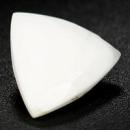|
Priceite,
also known as "Pandermite," is a white, marble-like
mineral. Although it is now called Priceite, it was
once known as Pandermite after the Panderma area (now
called Bandirma) of Turkey. The material from the Panderma
area was thought to be a type of marble and was used
for carving statues. One of these statues was analyzed
by French amateur chemist Desmazures in 1865 and found
to be high in boran. This "Pandermite" was
later described as a new calcium borate mineral species,
published in 1877, but by that time the mineral Priceite
from California, USA had already been described four
years previously. So the name Priceite has precedence
even though Pandermite was known earlier.
There
are a mumber of Priceite localities including: in the
USA, from eight km north of Chetco, Curry County, Oregon;
in California, from a number of occurrences around Death
Valley, as the Monte Blanco area, in Corkscrew Wash,
and the Furnace Creek district, Inyo County From the
Penobsquis and Salt Springs evaporite deposits, near
Sussex, New Brunswick, Canada. At Mesa del Almo, 13
km southeast of Magdalena, Sonora, Mexico. In Turkey,
from the Sultan¸cayir borate deposit, Bursa Province,
and in several deposits in the Bigadiç borate district,
Balikesir Province. From the Inder borate deposit, Kazakhstan.
At Meldon, Okehampton, Devon, England. From the Pöhla
mine, Schwarzemberg, Saxony, Germany. At Radotin, Czech
Republic.
|
